Pixel 7 Pro vs Galaxy S22 Ultra: top dogs of the past
We may earn a commission if you make a purchase from the links on this page.

Intro
The Pixel 8 series is out, which made the Pixel 7 phones are a thing of the past — a two-year-old relic. Well, not really, Google actually still proudly sells them from the Google store, and still at the original MSRP since the new Pixel 8 phones are more expensive. So, the Pixel 7 starts at $600 and the Pixel 7 Pro is $900, which may be a bit much for an 18-month-old flagship. Thankfully, sales events and carrier promos often cut these down generously.
Samsung's Galaxy S22 Ultra hails from the same year as the Pixel 7... though it was a few months earlier. By now, the Galaxy S22 phones are discontinued by Samsung. You can find the odd new-old-stock unit in a random store, or you can shop them pre-owned and refurbished to save some extra cash.
So... a previous generation Galaxy Ultra or the old Pixel 7 Pro — what's better? Which one has the better camera? How does the Tensor G2 processor compare to the Snapdragon 8 Gen 1? And what about battery life?
Pixel 7 Pro vs Galaxy S22 Ultra in a nutshell:
- Google Android vs Samsung One UI
- CPU: Tensor G2 vs Snapdragon 8 Gen 1 (or Exynos internationally)
- 6.7" 120 Hz OLED vs 6.8" 120 Hz AMOLED
- Triple camera with 30x zoom vs quad camera with 100x zoom
Table of Contents:
Read more:
- Pixel 7 Pro vs Pixel 6 Pro
- Pixel 7 Pro vs iPhone 14 Pro Max
- Pixel 7 vs Galaxy S22
- Pixel 7 vs iPhone 14
- Best Android phones
- Best Samsung phones guide
Design and Display Quality
We are OLED to see you
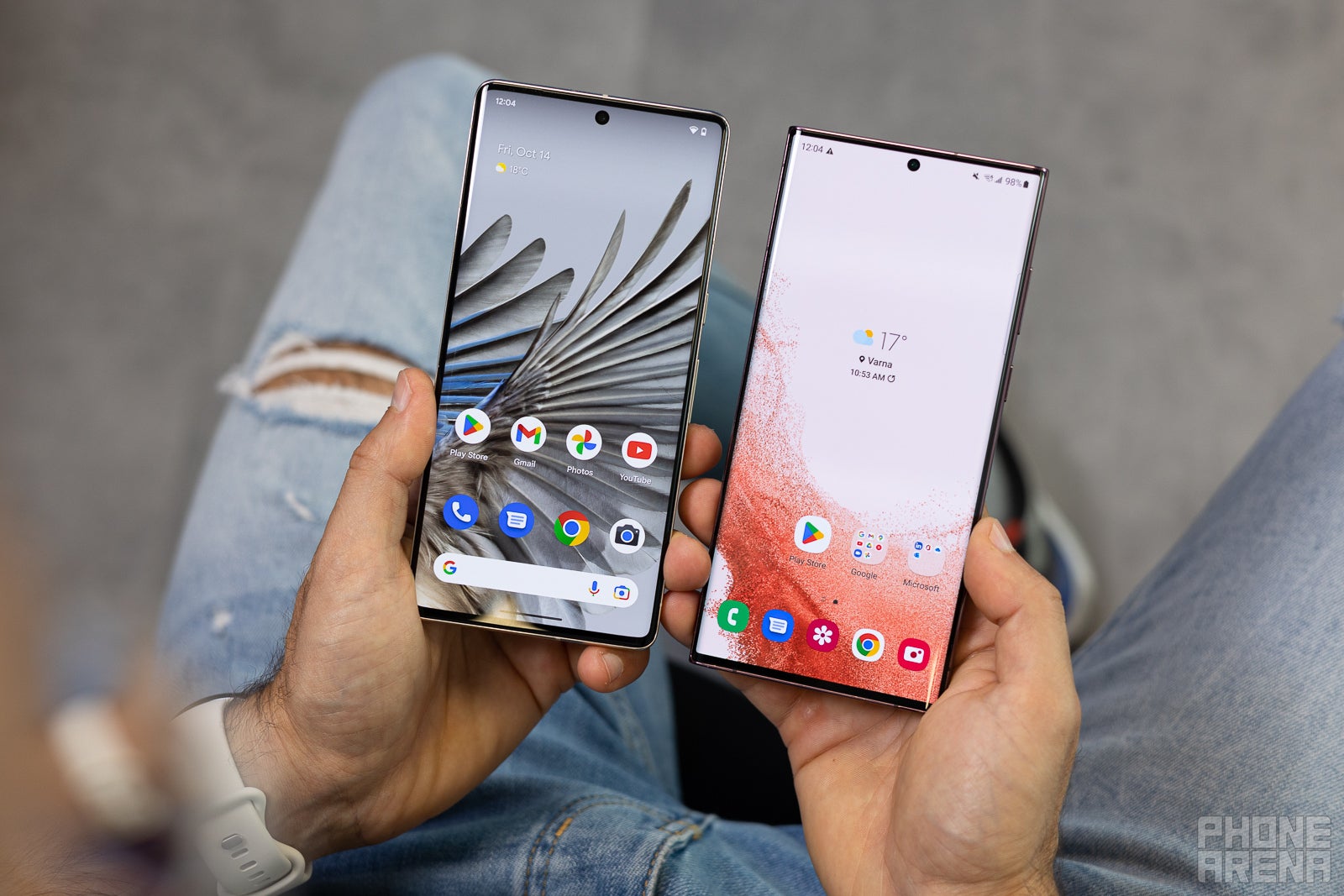
In terms of screens, we have two high quality OLED panels duking it out. Samsung has been on top of its display game for years now and the Dynamic AMOLED of the Galaxy S22 Ultra looks just fantastic. It also helps that there are a couple of calibrations to pick from, so you can really fine-tune your experience, whether you want punchy colors or subdued and realistic hues. The Pixels' OLED screens are also pretty good, so it's a close call here. Plus, both phones have 120 Hz refresh rate and QHD resolution, so it's a tough one.
OK, the Pixel 7 Pro has a slightly smaller 6.7" diagonal vs the 6.8" on the Galaxy S22 Ultra. But it's also sharp and vibrant, though maybe it doesn't pop as much as the Samsung's.
In terms of looks, we have distinct designs on both phones. Curved screens on the front, yes, but wildly different back sides. The Pixel 7 Pro repeats the camera bar design, but dresses it in metal this time around, Samsung is doing its corner camera glued to the frame of the device. Both designs have proponents and haters. We at the office are also divided, so it's safe to say that this one is strictly up to taste.
The S22 Ultra has a matte glass back — fantastic for keeping fingerprints away, not so great for being slippery against dry hands. The Pixel has a glossy finish, which may collect and show more fingerprints, but is sticky against the skin. The Pixel's camera bar has also proven itself helpful by allowing us to comfortably rest our fingers against it and grip the device better.
OK, the Pixel 7 Pro has a slightly smaller 6.7" diagonal vs the 6.8" on the Galaxy S22 Ultra. But it's also sharp and vibrant, though maybe it doesn't pop as much as the Samsung's.
Display Measurements:
In terms of looks, we have distinct designs on both phones. Curved screens on the front, yes, but wildly different back sides. The Pixel 7 Pro repeats the camera bar design, but dresses it in metal this time around, Samsung is doing its corner camera glued to the frame of the device. Both designs have proponents and haters. We at the office are also divided, so it's safe to say that this one is strictly up to taste.

Needless to say, both phones are water- and dust-resistant. The Galaxy S22 Ultra has an IP68 rating, and so does the Pixel 7 Pro. Perks like stereo speakers, wireless charging, and the complete lack of a headphone jack are also present. But the Galaxy S22 Ultra does have the coveted S Pen for anyone who prefers annotating or drawing on their phone. There's a good reason why the S Pen has stuck around for a decade — it is useful and it feels awesome.
When it comes to colors, you do have a wider choice if you go for the S22 Ultra, but only if you buy from Samsung.com. Retailers get black, white, burgundy, and green, while Samsung's web shop offers sky blue, red, and graphite. The Pixel 7 Pro colors are a bit more basic, but still have a stylish gleam to them. They are black, white, and a gray with a gold frame (a.k.a. Obsidian, Snow, and Hazel).
In terms of security, we have an under-screen fingerprint scanner on both phones. Samsung uses its ultrasonic fingerprint scanners, which the company says are more accurate and harder to fool. In recent models, they have also become fairly quick and dependable. The Pixels use optical scanners — the ones on the Pixel 6 series were kind of slow. But the Pixel 7 did get a slight upgrade. We'd say the fingerprint scanner on the 7 Pro is slightly slower than a perfect seamless feel, but we wouldn't call it a disappointment.
Performance and Software
Wait, so are Exynos and Tensor brothers?
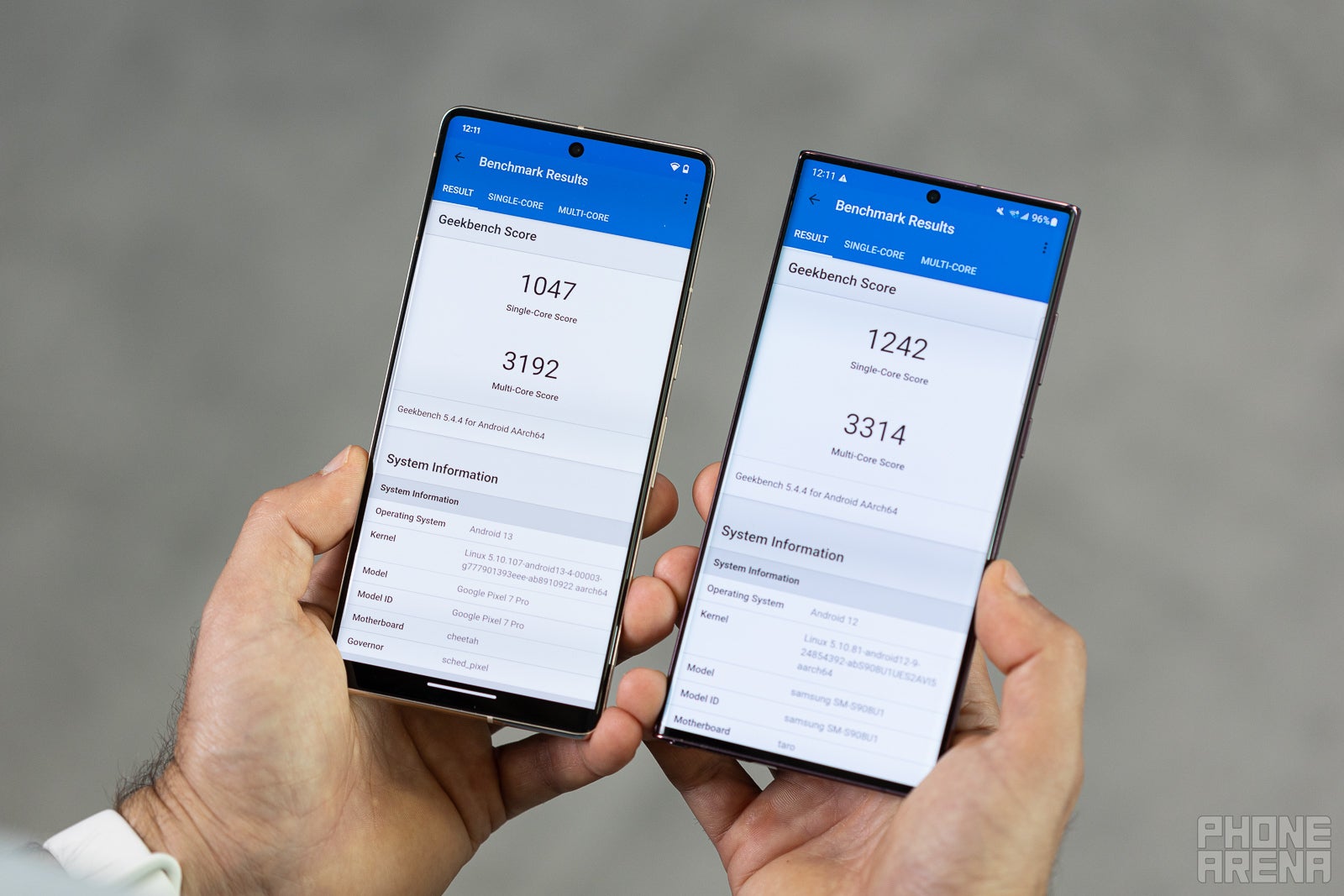
Google uses a custom Tensor chip for its Pixel phones since 2021. In the Pixel 7 line, we get the new Tensor G2. Google didn't spend any time talking about any numbers or performance improvements and for the most part, the Tensor G2 lags behind the top tier competition. Not that it's bad... mostly, it's not as insanely fast.
In the meantime, Samsung's Galaxy S22 Ultra is powered by the Qualcomm Snapdragon 8 Gen 1 (in the USA and South Korea) or Samsung's own Exynos 2200 chip (international markets).
What does this mean in terms of performance? Well, Tensors have never been productivity monsters. They focus on having cores dedicated for computational photography and AI functionality. In other words, Google is taking the "Work smart, not hard" approach.
That said, we didn't ever feel that the Pixel 7 Pro is slow or unresponsive. Yes, the Galaxy S22 Ultra's Snapdragon 8 Gen 1 can run half a lap more by the time the Tensor G2 is done, but in real life, we didn't feel like the latter was giving us a lesser experience. Maybe the Snapdragon has more power on tap to provide a better performance throughout the years. Maybe. But we can't talk a lot on future-proofing until we... get to the future.
So, when it comes to software, the Pixel 7 Pro is obviously loaded with the latest Android on board and has some exclusive features. Transcribing voice messages to text, improved speech-to-text that understands emoji prompts better, call screening, direct-my-call (guides you faster through automated voice calls), and image de-blur. The latter is an evolution of face unblur, which can now sharpen up your fuzzy pictures... all of them. You took a blurry photo back in 2007? Import it into Photos on the Pixel 7 and let the Tensor G2 make it better!
Samsung, on the other hand, has the One UI interface on top of Android, which specializes in multitasking and productivity. Especially with the S Pen and the large screen — there's a reason why people loved the Note devices and have now moved onto the Ultra line. The Bixby AI is nowhere near as effective and the Google Assistant on non-Pixel phones doesn't have as many features. So, you trade some AI smarts for a UI that is incredibly customizable, puts focus on split-screen, and an integrated S Pen, which is just excellent to write or draw with.
And we can't go on without shouting out Samsung's DeX — it's a niche feature, but a good one! Connect your Galaxy S22 Ultra to an external screen or an old laptop via a USB cable and it can "take over" that machine, and give you an Android-powered desktop interface. With the S22 Ultra's strong CPU behind it, you can absolutely do some work on DeX — so long as it's about document editing and some image modification (with the proper apps).
As for Android updates — Google promises three major Android updates post-release, Samsung goes for four. So, both of these phones should get up to Android 16. Also, both manufacturers commit to 5 years of security patches, so both the S22 Ultra and the Pixel 7 Pro should hit end-of-life in the same year (2027).
Camera
King, meet The King
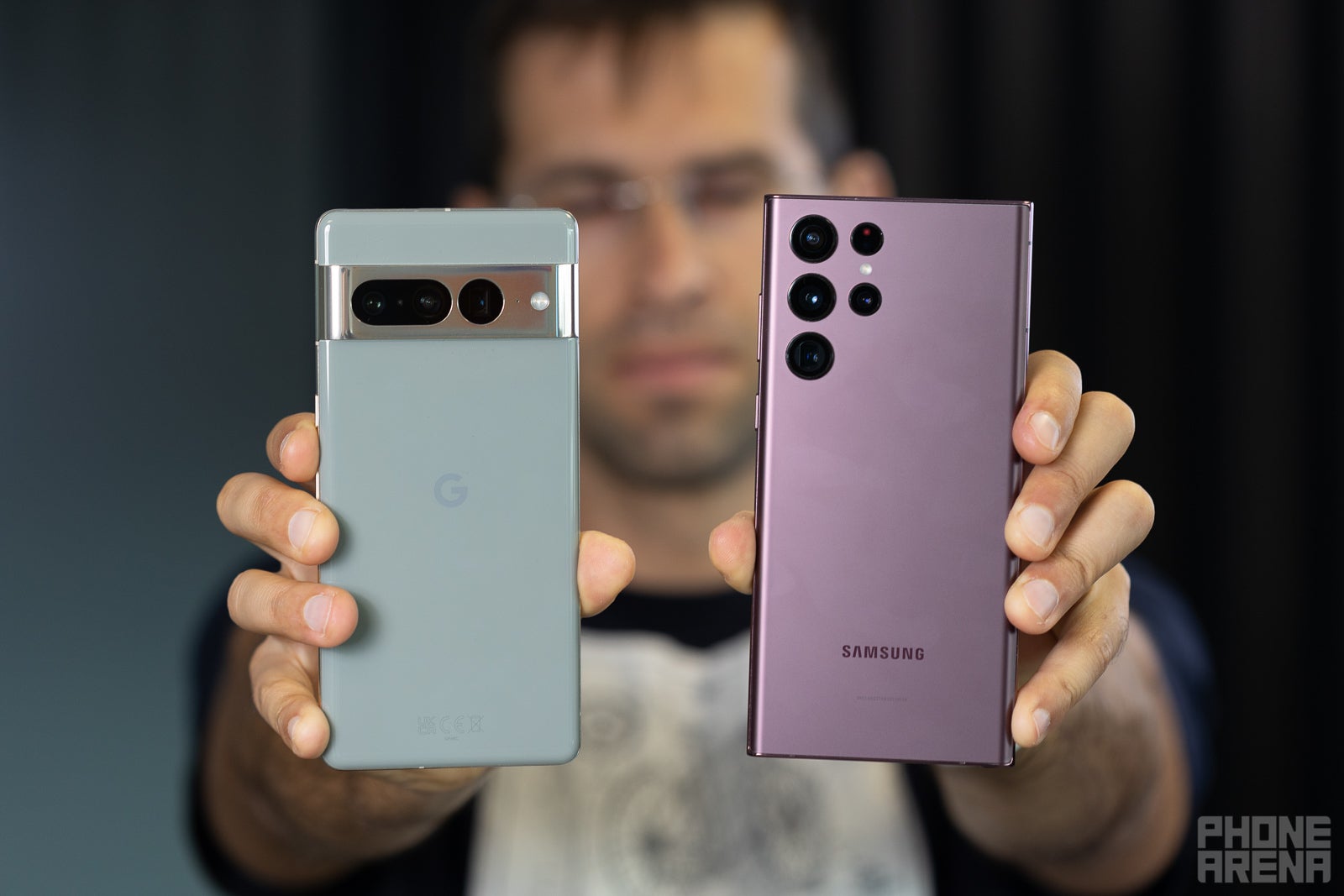
OK, so Samsung is pretty good with its cameras, right? The Galaxy S22 Ultra is basically a champ — it has four cameras, two of which are dedicated to optical zoom (a 3x portrait camera and a 10x zoom camera), and tons of software post-processing that allows for 100x digital zooming that looks much better than it should, really. The main sensor is a massive 108 MP one, the ultra-wide camera has a 12 MP one, and the zoom cameras are both 10 MP.
The Pixel 7 Pro kept the 50 MP main shooter from its predecessor, has a new 5x zoom lens with a 48 MP sensor, and a 12 MP ultra-wide camera.
Before we move on to the new zoom, here are some photos with the main and ultra-wide cameras:
Samsung is going for a very specific, signature look. Exposure and colors are dialed up, and sharpness is slightly too... well, sharp. Now, if you just want to point-and-shoot and share on social media, these photos will definitely draw attention. However, when putting them up next to the Pixel 7 Pro's photos, we can't help but prefer the latter more. The Pixel's camera is more subdued, more realistic in terms of colors and dynamics. Details are sharp but not as oversharpened.
OK, what's up with the zoom camera — the Pixel 6 Pro had a 4x lens. Now, Google upgraded it to a 5x, but that's not all. By using an updated Super Res Zoom algorithm, Google uses a crop into that 50 MP main sensor and mixes it with information from the 5x camera to achieve higher-detailed zooms at all levels between 2x and 5x. Essentially, Google is trying to simulate an actual zoom lens, where you are free to dial in any level of magnification and still get a sharp photo. For a first attempt? Pretty impressive!
At 3x zoom, the results are pretty similar — this is where the Samsung has a telephoto lens for optical zoom, and the Pixel uses the ultra-wide and telephoto mixed to get its details. It's almost too hard to tell it's a digital zoom, if it weren't some artifacting around the edges of some objects. It's also worth noting that the Samsung's tendency to expose shots too much results in blown out highlights that the Pixel managed to tame quite nicely.
At 5x zoom, the Pixel's telephoto kicks in and it regains a lot of details and natural looks. The Samsung, at 5x, needs a digital crop, and the photo looks a bit washed-out.
At 10x zoom, Samsung again has a telephoto lens to use for full optical magnification. Thus, it looks sharp and detailed. The Pixel 7 Pro did quite well at 10x, but we can definitely see some noise starting to pop up.
30 is the maximum the Pixel can go to and it taps out. And, actually, we'd say the details in the 30x shots are pretty similar on both the Samsung and the Pixel samples. However, the Galaxy S22 Ultra's tendency to dial contrast and colors up gives it a slight edge, as it appears like the picture pops out more. The Pixel photo, with the more natural colors and all the noise from the digital zoom, doesn't look as exciting. On its own, however, it's still pretty impressive for a 30x zoom!
Now, both of these phones have a Portrait Mode, but we feel the Galaxy has the Pixel kind of beat in this category:
The Pixel 7 Pro portraits, by themselves, are often not bad. However, since Google doesn't have a dedicated portrait lens, the Pixel will crop in for a digital zoom while shooting these photos, resulting in less detailed images. When comparing to the Galaxy S22 Ultra, we can spot that Samsung has figured out a way to blend subject edges into that faux bokeh in a way that tricks the eye a bit better, and also manages to save rogue strands of hair somewhat.
Taking them out in the evening for some Night Mode testing!
Safe to say, both of these phones' ultra-wide cameras did not do as good in night time — the image quality gets fuzzy fast with those lower-res sensors and their smaller apertures. With the main cameras, we do get great night time photos from both phones.
Safe to say, both of these phones' ultra-wide cameras did not do as good in night time — the image quality gets fuzzy fast with those lower-res sensors and their smaller apertures. With the main cameras, we do get great night time photos from both phones.
The Pixel 7 Pro kind of knocked it out of the park, giving us slightly sharper pictures with more realistic auras around the decorative lightbulbs. The Galaxy S22 Ultra, by itself, is very, very good... but compared to the Pixel — it slightly drops the ball in terms of handling dynamics and pulling more realistic colors from the scene. Slightly!
Let's take a look at some selfies with the Pixel 7 Pro's 11.1 MP vs the Galaxy S22 Ultra's 40 MP front cameras:
Day, dusk, and night — the Galaxy S22 Ultra does offer a slightly more detailed photos with more facial features. It does have a bit of a yellow cast, though, where the Pixel photos look a bit more natural. And, at night, both selfie cameras got kind of fuzzy, so no major brekthroughs here.
Oh, also, the Pixel 7 Pro's ultra-wide camera takes a page from the iPhone and also doubles as a high-quality macro camera — that's something that Samsung also has in the hidden "More" modes menu in the Camera app.

Audio Quality and Haptics
In terms of haptic response — both the Pixels and the Galaxies have precise and responsive, clicky vibration motors. The Pixel's feels awesome, the Galaxy's is very good, but maybe a pinch less strong.
In terms of audio, the Galaxy S22 Ultra is very good and allows further tuning via an on-board app. The Pixel 6 Pro was a bit disappointing — not bad, but not amazing. We will see how the Pixel 7 Pro presents itself.
In terms of audio, the Galaxy S22 Ultra is very good and allows further tuning via an on-board app. The Pixel 6 Pro was a bit disappointing — not bad, but not amazing. We will see how the Pixel 7 Pro presents itself.
Battery Life and Charging
A day for a day
The Pixel 7 Pro has a 5,000 mAh cell and Google promises a beyond-24-hour battery life. Fair enough, that's a pretty big battery! That's what the Pixel 6 Pro had and it's generally what most mainstream smartphone makers manage to cram into their devices.
The Galaxy S22 Ultra also has a 5,000 mAh battery. It's no battery champion, but it can comfortably last you a day. We'd wager the Pixel 7 Pro will give us the same result.
As for charging, the Galaxy supports up to 45 W Fast Charge. The Pixel 7 Pro is listed to require a 30 W wall plug, but in reality it limits charging to about 23 W. Both of these phones will come without a charger in the box, so keep these numbers in mind when shopping for one.
If you buy the optimal charging plug (you can always go with the official one), you can expect both of these phones to be able to go from 0% to 100% in less than two hours.
Wirelessly, the Galaxy S22 Ultra can get charged by 15 W pucks, whereas the Pixel 7 Pro can take 23 W for a slightly faster top-up. Both of these phones can do reverse wireless charging, too (or Power Sharing).
Specs Comparison
Putting it all together and looking at raw sheet data side-by-side looks like this at the moment:
| Specs | Google Pixel 7 Pro | Samsung Galaxy S22 Ultra |
|---|---|---|
| Dimensions | 6.4 x 3.0 x 0.3 inches (162.9 x 76.6 x 8.9 mm) | 6.43 x 3.07 x 0.35 inches (163.3 x 77.9 x 8.9 mm) |
| Weight | 7.5 Oz (212 g) | 8.08 oz (229.0 g) |
| Screen | 6.7", OLED, 1440p, 120 Hz | 6.8", Dynamic AMOLED, 1440p, 120 Hz |
| Processor | Google Tensor G2 | Qualcomm Snapdragon 8 Gen 1 (Samsung Exynos 2200) |
| RAM | 12 GB | 8 GB |
| Rear Cameras | 50 MP wide-angle, 48 MP 5x zoom, 12 MP ultra-wide | 108 MP wide-angle, 10 MP 3x zoom, 10 MP 10x zoom, 12 MP ultra-wide |
| Front Camera | 11.1 MP | 40 MP |
| Battery Size | 5,000 mAh | 5,000 mAh |
| Charging Speeds | 30 W wired, 23 W wireless | 45 W wired, 15 W wireless |
| Price | $899 | $1,199 |
So, we have two phones that obviously are doing their own thing. The Pixel 7 Pro won't have the amazing zoom capabilities of the S22 Ultra, most probably, but we are pretty sure it'll be able to give its main camera a run for its money. Well... while costing less, that is. What remains to be seen is how the new Tensor will perform.
Summary and Final Verdict
It looks like the Pixel 7 Pro packs some heat! Google introduced it as a camera-centric phone and it definitely delivers! Plus, you've got all the smart Google Assistant features on board, which makes it feel like a phone that integrates into your life to make small tasks a bit easier.
The Galaxy S22 Ultra, on the other hand, is more powerful, has that lovely S Pen, and a focus on multi-tasking. Plus, DeX, which lets you bring your work anywhere, so long as you can get it connected to a screen with wireless peripherals or an old laptop.
Assuming that, theoretically, you can find them at the same price (the S22 Ultra being a previous gen model and all), it's a pretty tough call to make! The best we can tell you is — the Pixel 7 Pro will give you a great camera and a very clean, core Android experience, with enhanced Google Assistant AI functions. The Galaxy S22 Ultra will give you a ton of Samsung features, like DeX, Samsung SmartTags, and the S Pen. Both phones will perform fantastic, it's the peripherals you need to consider.
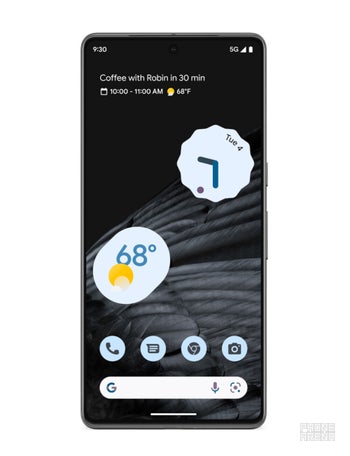
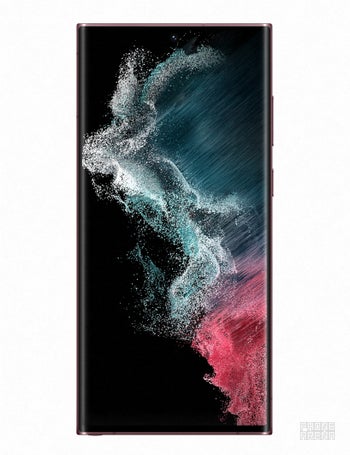















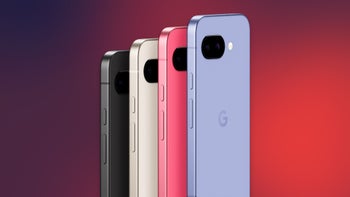
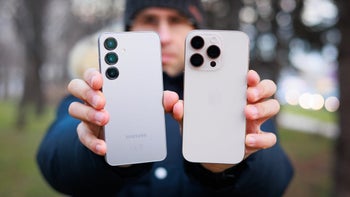

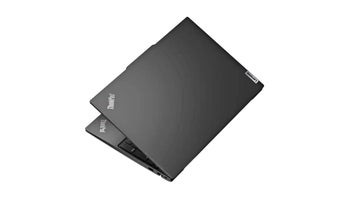






Things that are NOT allowed: